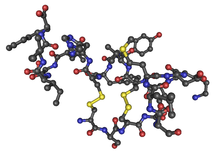Endothelin
| Endothelin family | |||||||||
|---|---|---|---|---|---|---|---|---|---|
 |
|||||||||
| Identifiers | |||||||||
| Symbol | Endothelin | ||||||||
| Pfam | PF00322 | ||||||||
| InterPro | IPR001928 | ||||||||
| PROSITE | PDOC00243 | ||||||||
| SCOP | 1edp | ||||||||
| SUPERFAMILY | 1edp | ||||||||
| OPM superfamily | 156 | ||||||||
| OPM protein | 3cmh | ||||||||
|
|||||||||
| Available protein structures: | |
|---|---|
| Pfam | structures |
| PDB | RCSB PDB; PDBe; PDBj |
| PDBsum | structure summary |
| Endothelin 1 | |
|---|---|
| Identifiers | |
| Symbol | EDN1 |
| Entrez | 1906 |
| HUGO | 3176 |
| OMIM | 131240 |
| RefSeq | NM_001955 |
| UniProt | P05305 |
| Other data | |
| Locus | Chr. 6 p23-p24 |
| Endothelin 2 | |
|---|---|
| Identifiers | |
| Symbol | EDN2 |
| Entrez | 1907 |
| HUGO | 3177 |
| OMIM | 131241 |
| RefSeq | NM_001956 |
| UniProt | P20800 |
| Other data | |
| Locus | Chr. 1 p34 |
| Endothelin 3 | |
|---|---|
| Identifiers | |
| Symbol | EDN3 |
| HUGO | 3178 |
| OMIM | 131242 |
| RefSeq | NM_000114 |
| UniProt | P14138 |
| Other data | |
| Locus | Chr. 20 q13.2-q13.3 |
Endothelins are peptides that constrict blood vessels and raise blood pressure. They are normally kept in balance by other mechanisms, but when they are over-expressed, they contribute to high blood pressure (hypertension) and heart disease.
Endothelins are 21-amino acid vasoconstricting peptides produced primarily in the endothelium having a key role in vascular homeostasis. Endothelins are implicated in vascular diseases of several organ systems, including the heart, general circulation and brain.
Endothelins derived the name from the fact that they were derived and secreted from cultured endothelial cells.
There are three isoforms (identified as ET-1, -2, -3) with varying regions of expression and binding to at least four known endothelin receptors, ETA, ETB1, ETB2 and ETC.
Earliest antagonists discovered for ETA is BQ123, and that for ETB is BQ788.
Endothelins are the most potent vasoconstrictors known. In a healthy individual, a delicate balance between vasoconstriction and vasodilation is maintained by endothelin and other vasoconstrictors on the one hand and nitric oxide, prostacyclin and other vasodilators on the other.
Overproduction of endothelin in the lungs may cause pulmonary hypertension, which can sometimes be treated by the use of an endothelin receptor antagonist, such as bosentan, sitaxentan or ambrisentan. The latter drug selectively blocks endothelin A receptors, decreasing the vasoconstrictive actions and allowing for increased beneficial effects of endothelin B stimulation, such as nitric oxide production. The precise effects of endothelin B receptor activation depends on the type of cells involved.
...
Wikipedia
